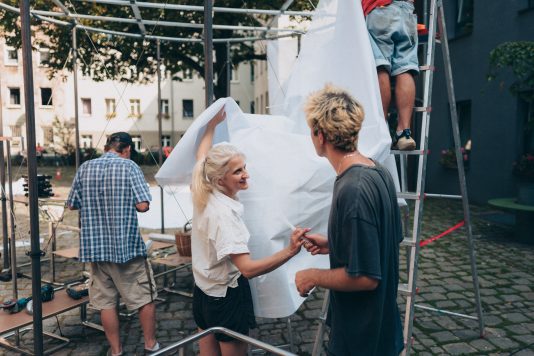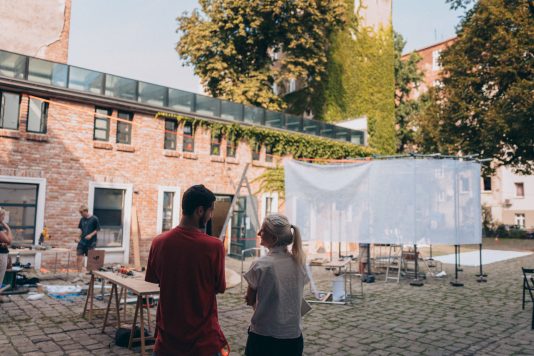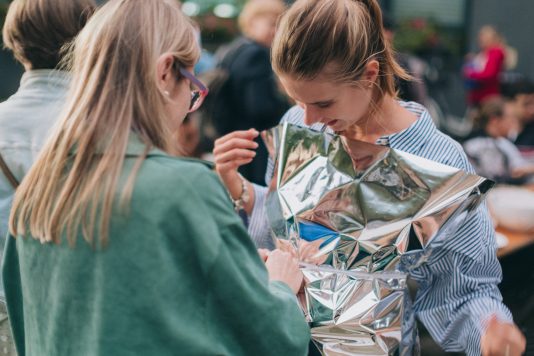How a courtyard can become an art studio and open kitchen
I believe that the first paragraphs of curatorial statements are akin to a well-crafted recipe. They should succinctly outline the essential elements of the demanding residential work, setting the stage for the outcomes that artists and participants will collaboratively produce. The initial tasks are non-negotiable; they cannot be glossed over or neglected, making the commencement particularly challenging. There is a persistent uncertainty, a fear that things might not unfold as intended.
During discussions with artists about the initial concepts for their works, I encourage them to provide enticing teasers and ideas. This approach laid the foundation for the commencement of this year’s final residency within the Magic Carpets Platform in Wrocław. In early April, I tasked Teresa Stillebacher with sending me precisely four sentences detailing her ideas for artistic activities in Wrocław. Her response was, “It would be great to create a type of open kitchen, where different people would cook each time. We could have a small infrastructure in the public space that I can build with the community. Seeing how various cultures and people open up during dinner and feasting together would be exciting. I think group cooking and eating together is the best way to share and express empathy.”
Teresa, an architect based in Innsbruck, envisioned her idea as a surreal scenario where an intricately designed kitchen occupies a prominent spot in one of the busiest streets in Wrocław, such as ul. Świdnicka leading straight to the Market Square. This vivid image involved people bringing diverse, colorful vegetables and utilizing designer stoves to cook something delectable. Furthermore, my imagination honed in on a pivotal culinary element – collaboration with other city residents. This aspect often serves as a bridge, connecting strangers and fostering new friendships. It presented a refreshing perspective, resonating with projects that involve the community.
Art courtyard
In the end, the pavilion found its place in a different location than the main street, yet it seamlessly complemented Teresa’s project. It settled in the district of Wrocław renowned for its captivating social initiatives, grassroots collaboration, and artistic corners – specifically in the Art Courtyard at ul. Rydygiera 25a. Before we delved into the all.cake.all.night project, my preconceived notions of Nadodrze, where the pavilion was situated, painted a different picture. I had heard disconcerting tales about this district, a place I seldom visited – stories of locals engaging in late-night mischief and alcohol-fueled gatherings. However, for the project’s creators, Teresa Stillebacher and the AestheticAthletics+ collective, Nadodrze proved to be exceptionally friendly, cozy, and welcoming. The structure received a warm reception from courtyard visitors and attendees of neighbour dinners organized in September and October within the pavilion. This urban intervention remained untouched until the end of the residency, capturing the attention of passersby and serving as a catalyst for numerous inspiring conversations and friendships.
From the outset, the potential of this hidden public space behind townhouses was palpable, signaling that it offered opportunities for spontaneous collaboration. The gatherings in the courtyard served as a reminder to participants that a small, functional infrastructure could be designed, leading one senior participant to express, while serving lecsó with potatoes, that “one autumnal evening made her feel like we all starred in a film.” The pavilion intervention fostered a sense of belonging to a network of local storytellers who delight in cooking, sharing recipes, and treating others to their homemade dishes. And it succeeded. In the Wrocław courtyard, the artists—Teresa, Borys, David, and Julien—gained enough confidence to realize a multigenerational vision in a multinational environment, despite not knowing Polish. This communal collaboration fueled our meetings, drawing many people back repeatedly. The artists worked with Tytus, an invited participant, who introduced residents to the secrets of second-hand objects that contributed to building the pavilion. Before the culinary adventure began, the artists meticulously scoured the urban fabric of Wrocław for elements for the installation. They aimed for the countertop and the pavilion’s construction to consist mainly of second-hand objects embedded in a local context, showcasing that architecture, even on a small scale, temporary, and stemming from an artistic vision, comes to life through a lengthy process of designing, drawing, space surveying, measuring, and hours of labor. The gathering of creative individuals whose projects are well-thought-out and grounded in honesty and openness to social needs proved crucial. In this case, the need revealed itself as cooperation and the sharing of work, kitchen, ingredients, and ideas. Importantly, the entire process was documented in a self-made publication, a compilation of records collected by Teresa and her friends from AestheticAthletics+. The book was publicly presented at the project’s finale at the end of October.
Why all.cake.all.night?
From the outset, the evening presented itself as the perfect time to connect with the residents of Nadodrze and Wrocław. The warm, intimate lighting and a countertop positioned at the centre of a circular pavilion created a relaxed atmosphere, encouraging participants to seamlessly engage in the performative activity of cooking. The circular design of the structure, inspired by a birthday cake, evoked memories of joyful family celebrations, adding a layer of familiarity to the setting. Sharing cake and discussing its flavours served as a compelling metaphor for people’s behaviour at the table, and the artists aimed to transpose this cozy atmosphere to their gatherings and collaborative cooking sessions. Throughout the residency, four dinners and one breakfast were organized. Additionally, a spontaneous yoga class, led by one of the participants and the creator of the excellent Tortilla de patatas, added a delightful element to the experience. At the third gathering, Hanna and Tadeusz Janczak joined us, contributing a performative reading of passages from their books and music. These grassroots activities further underscored the sense of belonging that flourished within the walls of the all.cake.all.night pavilion.
Curating all.cake.all.night revitalized my motivation to initiate activities in public spaces. The residency enabled me to involve numerous individuals whose contributions to erecting the pavilion are immediately apparent. This multifaceted engagement with the community brought advantages to everyone involved and contributed to the establishment of a self-sufficient micro-organism. Temporary initiatives involving local communities have a profound revitalizing effect. Empathetic collaboration with others became the most effective means to discover what I could contribute to a process that began many months ago as a curator, participant, and observer. And the participants themselves discovered this transformative aspect.
Resident: Teresa Stillebacher, the AestheticAthletics+ collective.
Curator: Paulina Brelińska-Garsztka
Place of residency: Art Courtyard of HART hostel at ul. Rydygiera 25a
Practice: architecture, performance, visual arts, culinary art
Local artist: Tytus Presiński (zresztek.pl)
Partners of the Presidency: Koło Naukowe Habitat, Koło Naukowe Humanizacja Środowiska Miejskiego, Hanna and Tadeusz Janczak, Art Courtyard of HART
WIK is a partner of the international platform Magic Carpets, co-funded by the European Union program Creative Europe, affiliating dozens of cultural organizations.
Curatorial text by Paulina Brelińska-Garsztka

























